The world of work has dramatically changed in recent years. Hybrid work schedules are no longer a trend — they’re the future.
As companies adapt to new ways of working, it’s essential to have a solid game plan in place.
That’s where hybrid scheduling can help you out.
In this article, we’ll explain what a hybrid work schedule is, explore the benefits it can bring your business, and provide practical tips on deciding which schedule type would best suit your team.
Are you ready to dive in? Let’s go.
What does “hybrid work schedule” mean?
A hybrid work schedule is a flexible work model that combines remote and traditional in-office work.
Unlike a fully remote work model, hybrid work allows employees to work on-premises for a certain amount of time. They work remotely for the rest. The amount of time an employee will spend in the office will vary depending on their company’s hybrid work policies.
Think of hybrid work as a “happy medium” between two work models. It offers employees the best of both worlds.
It’s also becoming increasingly common.
 |
A recent study predicted that 20% of eight-hour workdays will be completed from home in the future, indicating the growing popularity of hybrid work.
4 benefits of hybrid work
While the hybrid schedule is popular among employees since it allows for more flexibility and improves work-life balance, it can also significantly impact a business’s success.
Here are four (perhaps surprising) benefits of hybrid work:
1. Increased productivity
It’s a common misconception that in-person interaction leads to greater productivity.
In fact, this belief is one of the main reasons some companies are hesitant to embrace hybrid work. For example, in an interview, the CEO of Netflix revealed that he doesn’t “…see any positives. Not being able to get together in person…is a pure negative.”
However, as long as proper systems are established to encourage and support remote employees, remote environments offer benefits that improve productivity. These benefits include the following:
- Fewer distractions: With remote work, there are less distractions due to other colleagues, interruptions, or loud work settings.
- Reduced stress: Employees can work in a comfortable environment and reduce long commutes and time spent in traffic, thus reducing stress.
2. Improved employee retention
When employees are granted the option to work from home or other locations, they’re more likely to stay with a company long-term.
A 2022 study found that having the option to work from home just two days a week can reduce employee turnover by 35%.
One reason for this boost in retention is that people feel more empowered when they can work where they want. Employees feel more valued and trusted when they’re allowed to do their job in a way that suits them best — and without having to justify their work style to their managers or colleagues.
3. Reduced overhead costs
Companies that introduce hybrid work schedules into their workplace can save a significant amount of money. According to a 2021 report, “…employers can save an average of $11,000 a year for each halftime remote reworker.”
So it’s no wonder that large companies, including Apple, Spotify, and Slack, are already implementing a hybrid or remote work system.
With hybrid work, you can save on office space, supplies, and utility bills.
4. Gives flexibility to in-field workers
Hybrid work can provide the flexibility in-field employees need to complete their work efficiently.
With the option to only visit the office when needed, technicians, engineers, researchers and other professionals who work in the field can complete tasks on their own schedule, improving their time management and productivity.
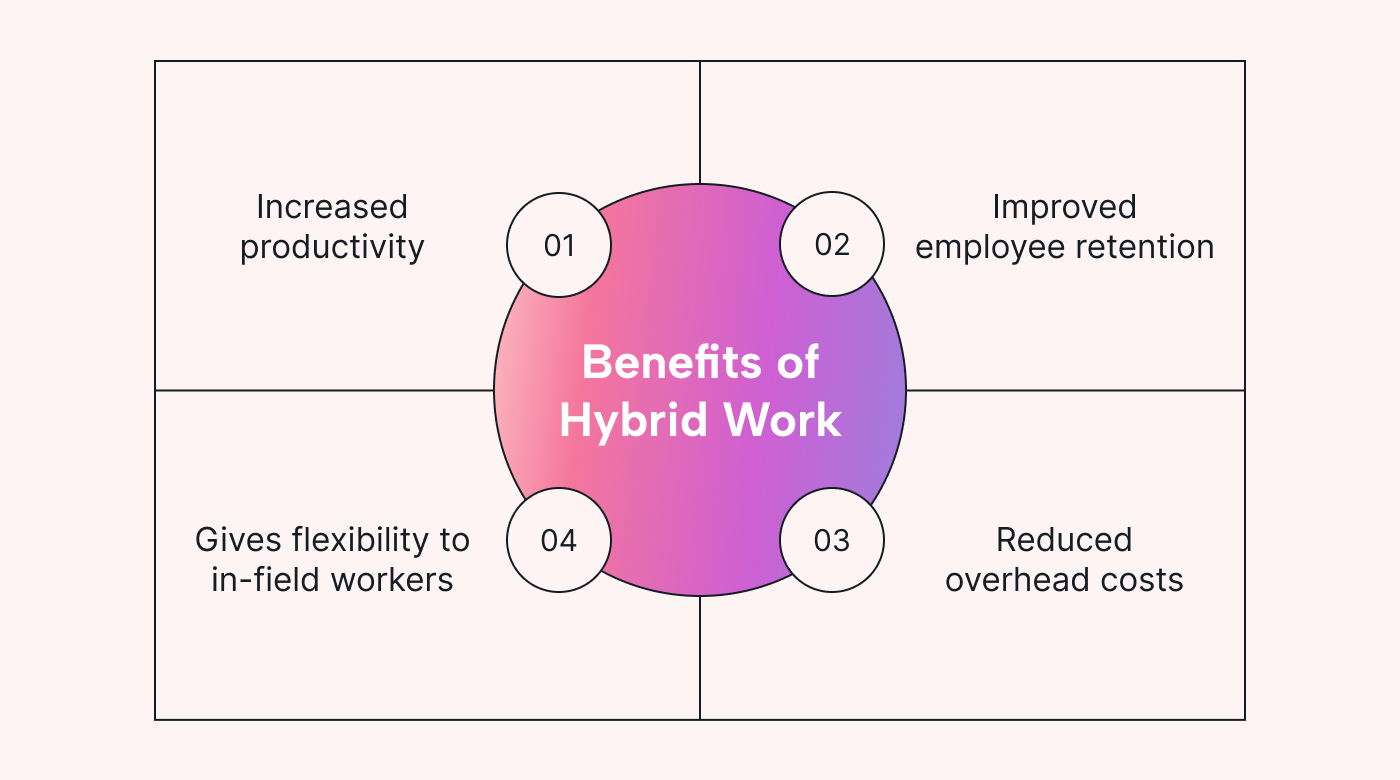 |
Project management software like Motion can also help increase your teams’ efficiency by 40%, as it makes planning and updating your calendar an automated process.
The most popular hybrid work schedule types
While hybrid work is a relatively new concept, businesses worldwide have embraced it, resulting in the emergence of multiple types of hybrid work schedules.
Here’s a list of the most popular hybrid work schedules being used right now:
Split-week
A split-week hybrid work schedule requires employees to work in the office for approximately half of the week while spending the other half working remotely.
Here’s an example: An employee may work from home on Mondays, Wednesdays, and Fridays. They come into the office on Tuesdays and Thursdays.
Pros:
- Allows employees to work in the way that best suits them
- Supports a healthy work-life balance
- Increases team cohesion and provides consistency
Cons:
- Increases potential for burnout
- Can lead to inconsistent productivity rates
- Requires additional technology and infrastructure
Core hours
The core hours model is when employees have a set number of hours during the day when they must be available for meetings or collaboration, while they can work however they choose for the rest of the day.
Here’s an example: Workers are expected to be in the office from 10 am to 2 pm every weekday but can work remotely for the remainder of the day.
Pros:
- Increases face-to-face interactions
- Ensures consistent availability
- Reduces social isolation and boosts team morale
Cons:
- Office hours are wasted on commute time
- Causes fatigue and brain fog
- Increases the chance of disengagement during meetings
Rotational
The rotational hybrid work schedule is similar to the “fly-in, fly-out” model where employees work in the office for a set period and remotely for a stint.
Here’s an example: Employees may work in the office for three weeks but remotely for the next two weeks.
Pros:
- Offers work variety, reducing the chance of boredom
- Increases workplace engagement
- Ensures shifts are evenly distributed
Cons:
- Can cause discrepancies in work quality and therefore impact career opportunities
- Makes building relationships with colleagues more difficult
- Limits access to resources and tools from one shift to the next
Flexible
The flexible hybrid work schedule is versatile, as it allows employees to choose when and where they work. Employees are still expected to complete set tasks, but they’re free to do so whenever they want to throughout the day.
Here’s an example: An employee chooses to work from home in the morning to avoid a long commute but visits the office in the afternoon to discuss project details.
Pros:
- Offers freedom for employees
- Reduces commuting time and costs
- Increases productivity
Cons:
- Makes distributing work evenly a challenge
- Can lead to communication breakdowns if proper systems aren’t put in place
- Makes coordinating meetings and schedules more difficult
Staggered
The staggered work model is when employees work on different schedules throughout the day, with some working during the day and others working at night.
Here’s an example: One team is in the office from 12–4 pm and works remotely from 5–9 pm, while another team works remotely from 12–4 pm and in the office from 5–9 pm.
Pros:
- Reduces office overcrowding
- Increases availability for customers
- Offers employees variety
Cons:
- Can lead to exhaustion due to night work
- Can cause resentment if schedules aren’t fairly distributed
- Increases time employees waste socializing after long periods of not working together
On-demand
This hybrid work schedule allows employees who primarily work in the office to take remote work days whenever they need to.
Here’s an example: An employee who has a doctor’s appointment in the middle of the day asks to work in the office on a project, take a break in the afternoon, and then continue working at home in the evening.
Pros:
- Ensures employees are utilizing their remote work time
- Improves job satisfaction
- Increases trust between employees and managers
Cons:
- Can limit flexibility throughout the week
- An employee may feel disadvantaged if everyone but them is in the office
- Limits hiring options to local residents
What’s the most effective hybrid work schedule?
There’s no one-size-fits-all solution to hybrid work schedules.
It’s important to consider your employees’ needs and the type of business you run before selecting which model is right for you.
Here are four examples of hybrid work schedules that would work well in different industries:
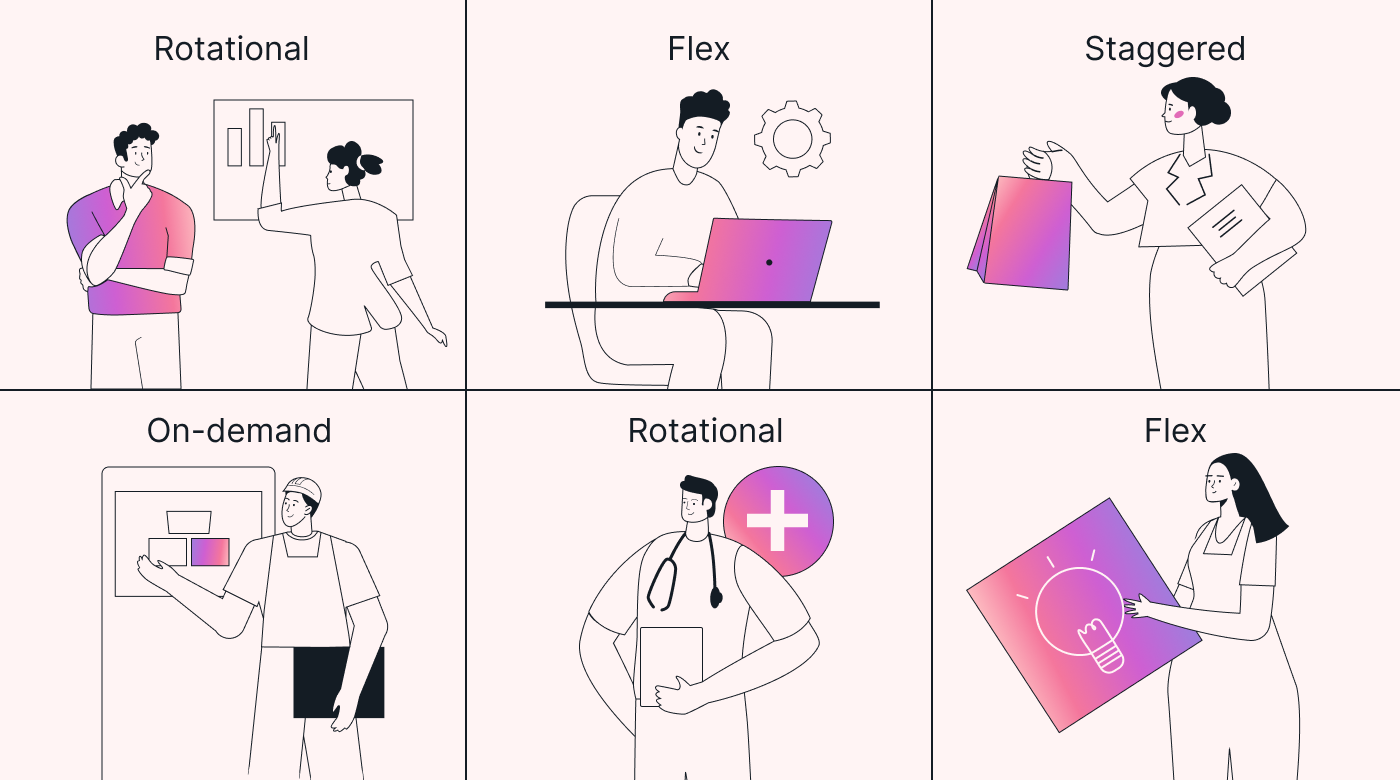 |
- Professional services firm: A rotational schedule would work well in this type of business, as it requires a significant amount of in-person interaction with clients while being heavily reliant on computers and bookwork.
- Technology company: A flexible schedule would be appropriate for a tech company since its employees primarily rely on computers to complete their work. They don’t need to meet face-to-face to complete tasks.
- Retail business: A staggered schedule would be convenient for a retail business. These companies often have a high volume of customers and need employees to be present in the store during business hours.
- Creative agency: A core hour schedule would be a great model for creatives, as it allows for lots of flexibility and fosters a culture of collaboration and targeted productivity.
How to choose the best hybrid work schedule for your office
Hybrid work will only be successful if your employees are interested in it.
Before choosing the best hybrid work schedule for your office, take a minute to contemplate what environment would best promote productivity in your workplace.
Factors to consider include:
- Employee preferences
- Communication and collaboration needs
- Workload and deadlines
- Technology and infrastructure
- Company culture
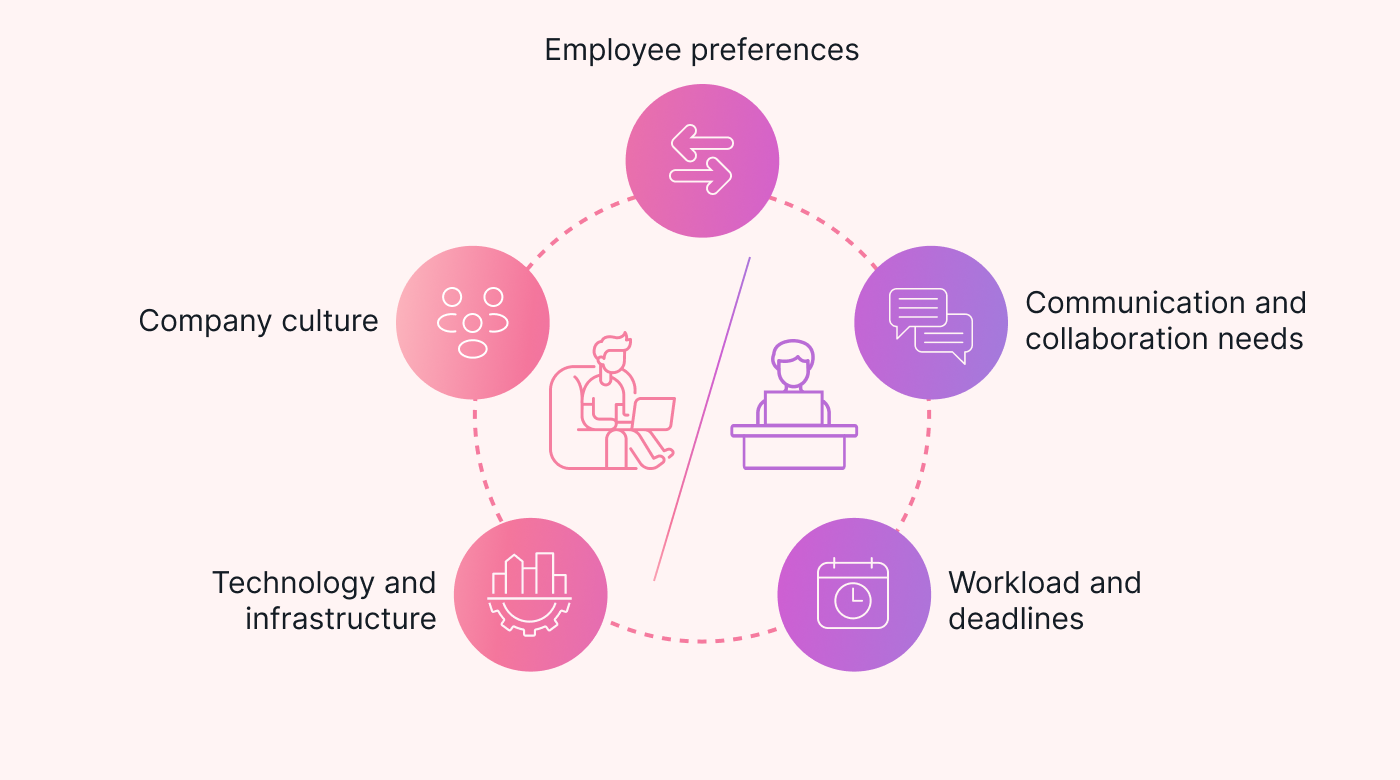 |
You can use the insights you gather to create a hybrid work schedule that works well for your employees.
A step-by-step guide to introducing a hybrid work schedule policy
Creating and enforcing a hybrid work schedule policy can be challenging.
The following steps will guide you through the process:
1. Communicate with your team
Before introducing a hybrid work schedule policy, you must determine how your team members prefer to work.
Two effective ways of gathering feedback are to:
- Conduct a short survey
- Question workers about their preferred work hours
Once you’ve determined the best schedule for your company, hold a meeting to provide clarity on what hybrid work entails and answer any questions your team may have.
2. Establish guidelines
It’s essential to establish guidelines for appropriate behavior when working remotely. Be crystal clear about what’s expected of hybrid employees.
Guidelines may include:
- Instructions for communicating over instant messaging and email
- Scheduling procedures
- Ongoing performance metrics
3. Determine logistics
It’s crucial to consider how a hybrid work schedule will work for your team. For example, is everyone going to be considered hybrid workers, or only certain team members?
4. Find the right tools
AI and automation can make your team’s tasks easier.
For example, Motion uses advanced technology to centralize information and project tasks for both in-office and remote workers. It also allows you to connect with your team at any time and review their upcoming work appointments and availability.
5. Provide training and support
Make training materials for the new tools and technologies employees will use while working remotely available.
While this transition will be difficult for some employees, a designated “support worker” can help guide struggling workers through any tech or communication problems they might face.
6. Monitor and adjust
Track the effectiveness of the hybrid work schedule you’ve chosen over time. If an element of the system is failing, try to address the issue swiftly.
Here are some signs that you need to adjust your hybrid work schedule:
- Employees are continuously falling behind on their tasks
- Communication has become vague and confusing
- Important documentation is constantly missing
7. Celebrate success
Don’t forget to celebrate your team’s success!
They’ve worked hard to make this model work, so make sure you reward them for it.
This could include simple actions, such as the following:
- Acknowledging achievements and milestones
- Throwing a mid-year office party
- Saying, “Thank you for your hard work this week” to each employee every Friday
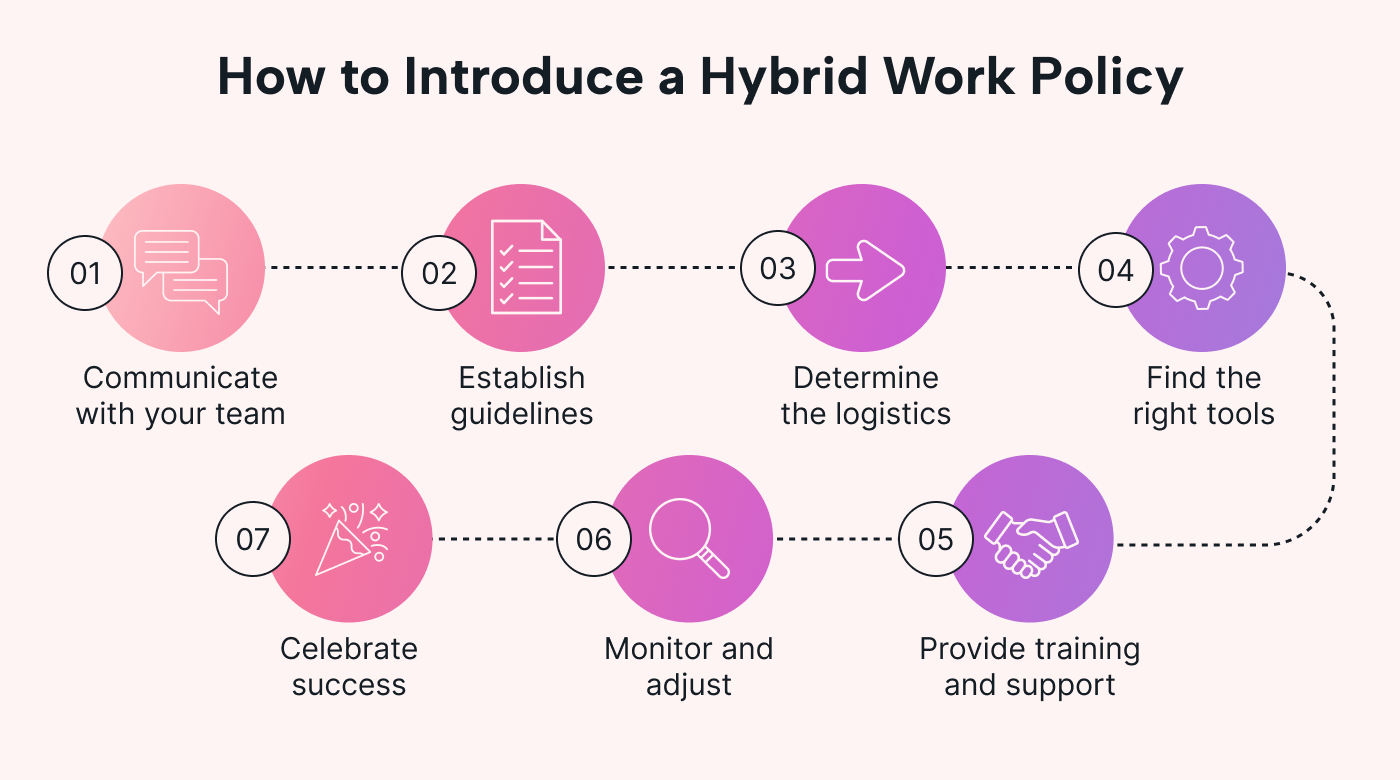 |
3 best hybrid work practices to follow
It’s important to establish clear and straightforward procedures from the beginning of your business’s transition to hybrid work.
Here are some essential practices to follow:
1. Establish clear communication protocols
With employees working in different time zones and locations, establishing clear communication protocols to ensure everyone is on the same page is important.
These could include:
- Scheduling team check-ins to monitor employee well-being and ensure everyone is aware of their responsibilities
- Using instant messaging and video conferencing tools
- Establishing acceptable response times for managers, remote employees, and in-office workers
2. Set clear goals and expectations
When some employees work in the office and some work remotely, it can be challenging to ensure that everyone is working toward the same goals.
Employees can better carry out their roles and meet their objectives when the business establishes a clear plan of attack.
This could include:
- Setting deadlines for all tasks, including minor ones
- Establishing fair performance metrics, such as the number of completed tasks in a week or positive customer reviews
- Providing regular feedback on submitted work
3. Prioritize employee well-being
With the blurring of lines between work and home life, it’s important to prioritize employee well-being to ensure your workers maintain a healthy work-life balance and avoid mental health issues.
This could include:
- Providing resources for online or in-person mental health support
- Encouraging employees to take regular breaks
- Leading by example by disconnecting from communication channels after work hours
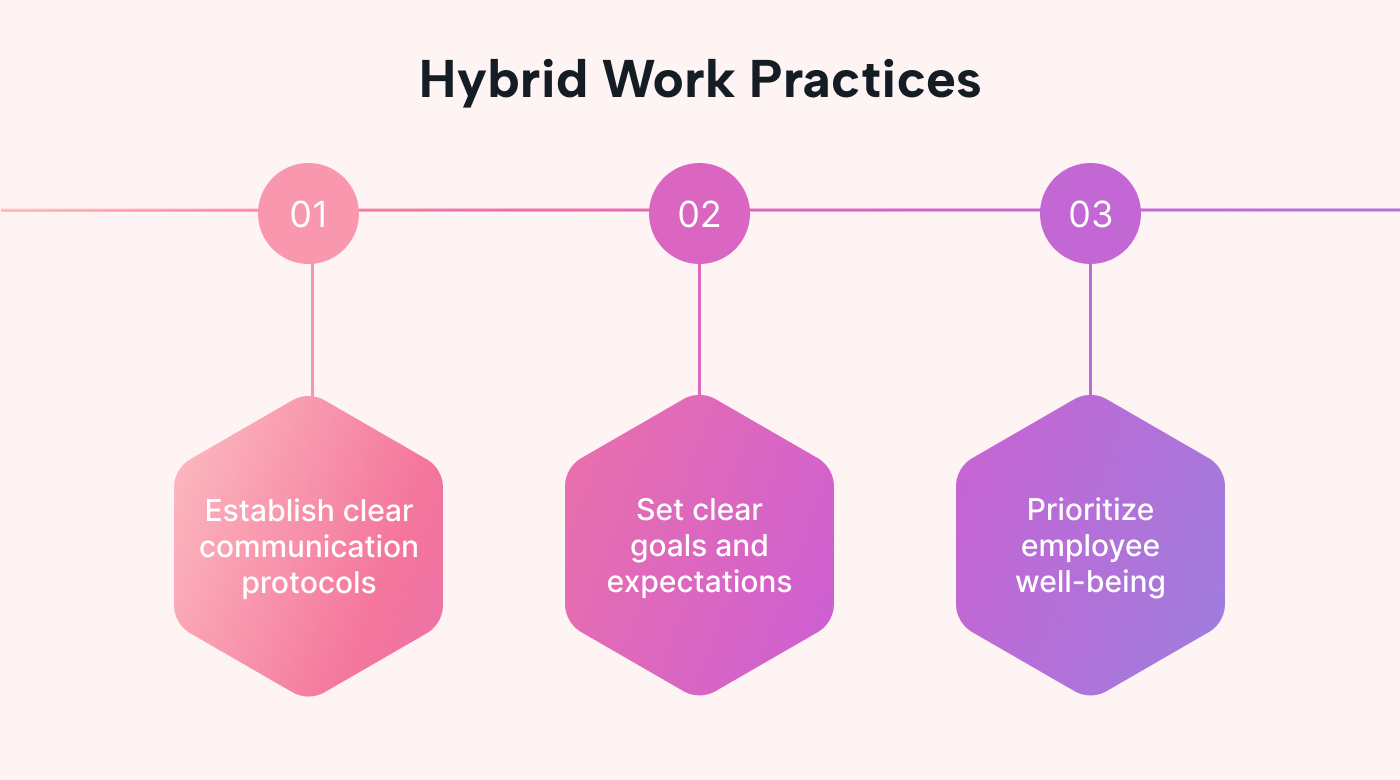 |
The future of work is hybrid
While we can’t predict everything the future holds, we can say with confidence that hybrid work schedules are probably here to stay.
Remember that effective communication, trust, collaboration, and the right tools are essential to making the most of this new way of working.
Change can be daunting, but with the help of automation and AI-powered tools like Motion, you can make the transition to hybrid seamless.
Try Motion for free today and see firsthand why over 20,000 customers are already benefiting from its many helpful features.





